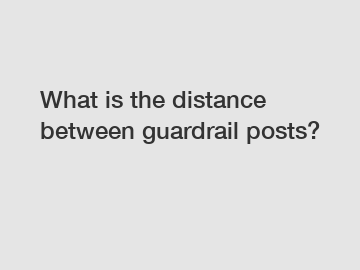What is the distance between guardrail posts?
What is the Distance between Guardrail Posts?
Guardrails play a crucial role in improving road safety by preventing vehicles from veering off the road or crossing into oncoming traffic. These protective barriers are typically made up of a series of posts and rails designed to absorb impact forces and redirect vehicles. One important factor to consider when installing guardrails is the distance between the posts, as this can significantly impact the barrier's effectiveness. In this article, we will explore the standard guidelines and considerations for determining the distance between guardrail posts.
Importance of Proper Distance between Guardrail Posts.

The distance between guardrail posts is an essential aspect to ensure the structural integrity of the barrier system. Incorrect spacing can compromise its ability to withstand impact forces and redirect vehicles effectively. When guardrail posts are too far apart, there is an increased risk that the rail will not be able to withstand the force of a vehicle collision, potentially resulting in a breach that allows the vehicle to pass through or over the barrier. On the other hand, if the posts are too close together, it can restrict the flexibility of the guardrail, preventing it from absorbing impact forces and potentially causing it to fail.
Standard Guidelines for Distance between Guardrail Posts.
Various standards and guidelines have been established to ensure consistent and effective guardrail installation. In the United States, the Federal Highway Administration (FHWA) has set guidelines for the spacing of guardrail posts, known as the W-beam guardrail system. According to these guidelines, the distance between guardrail posts should not exceed 6 feet and 3 inches (1.91 meters). This distance is measured from the center of one post to the center of the next adjacent post.
Factors Affecting Distance between Guardrail Posts.
While the FHWA provides general guidelines, the specific spacing requirements for guardrail posts can vary based on several factors:
1. Road Type: The type of road where the guardrail is installed can impact the spacing between posts. Highways and roads with higher traffic volumes may require more frequent guardrail posts to ensure maximum protection.
2. Speed Limit: The designated speed limit for the road can influence the guardrail post spacing. Higher speed limits increase the energy of vehicle impacts, requiring closer post spacing to absorb and redirect this energy effectively.
3. Crash History: Analyzing the crash history of a specific road section can provide valuable insights into the appropriate spacing for guardrail posts. Areas with a higher frequency of accidents may require closer post spacing to improve safety.
4. Soil Conditions: The stability of the soil where the guardrail is installed can also affect post spacing. Soft or unstable soils may require more frequent posts to ensure the structural integrity of the guardrail system.
Contact Us for Expert Guardrail Installation.
To ensure proper spacing and installation of guardrail posts, it is crucial to consult with experienced professionals. If you need assistance with guardrail installation or have any inquiries regarding road safety, do not hesitate to contact us. Our team of experts is dedicated to providing top-notch services and expert advice to guarantee the highest level of road safety for drivers and pedestrians.
In conclusion, the appropriate distance between guardrail posts is crucial to the effectiveness of the protective barrier. Following the guidelines set by regulatory authorities, considering road type, speed limit, crash history, and soil conditions, will help determine the appropriate spacing. For all your guardrail installation needs, remember to contact us, and our team will be more than happy to assist you.
If you want to learn more, please visit our website Thrie Beam Guardrail Wholesale, Steel H Post for Highway Guardrail, Guard Rail Post Wholesale.
126
0
0


Comments
All Comments (0)